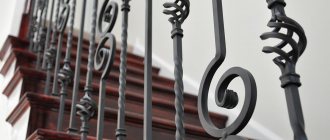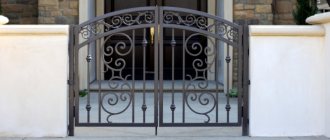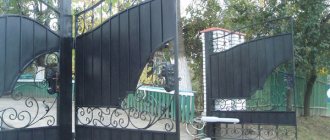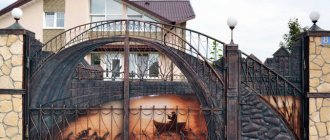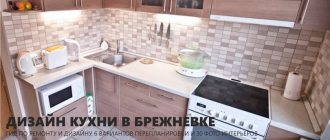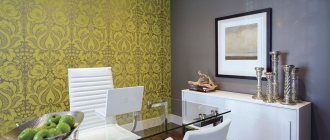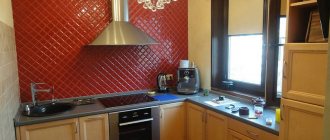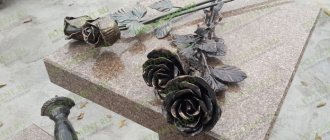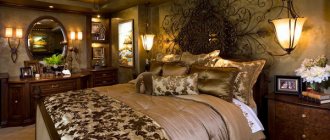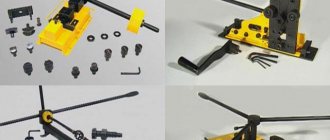Designer forged products in the interior are rich, exotic and grandiose. Despite their metallic composition, from which it is not so easy to create the desired ornament with the help of deft blacksmithing, they can be not only rough and monumental, as in bygone times, but also sophisticated, practical jewelry works of art, distinguished by their elegance, solidity and eccentricity of texture.
Designer forged balusters in the luxurious interior of a white living room act as a bright accent
Artistic forging - what is it?
It is the production of refined products by hot or cold processing of various metals and their alloys. Such items appear highly detailed, more reminiscent of jewelry work rather than simple craftsmanship performed with hammer, flame and anvil. Artistic forging is used not only to create external architectural elements of a building, such as railings, window grilles or gates, but also for more interesting paraphernalia, which in itself is of high value, since it is made by the hands of a master and, most likely, according to an individual sketch , no longer exactly repeatable by other creators. That is why forged accessories in the house are usually found in aristocratic mansions or expensive city apartments.
Artistic forging made of aluminum in a long corridor serves as a decorative component of the room
Look at the project : Interior of the Zhedochi house.
What can you do yourself?
Many believe that it is impossible to create a high-quality forged product with your own hands, others believe that there is nothing particularly difficult in blacksmithing, since our ancestors were successfully engaged in it in ancient times. Both of them are wrong. In order to forge even a small element yourself, you need not only tools and skills, but also knowledge of the properties of metals. Hot forging is hard work in conditions that are very far from office conditions. What to do?
If you don’t want to build a forge and master the technology of blacksmithing, you can limit yourself to an analogue of artistic forging. We will create a welded structure from metal profiles and rolled metal, which can be decorated with ready-made artistic forging parts. For this we will need: a source of electricity; a flat surface for assembling the product; grinder with metal brushes, cleaning and cutting wheels; non-stretch rope, marker; hammer, two pins; welding machine with mask, gloves and electrodes.
Even without a forge, you can eventually learn how to make real masterpieces
We will use metal profiles and rolled metal as materials. It is better to take the latter with a smaller cross-section, since then we can bend it without resorting to special heating conditions.
- Select a drawing. Do not complicate the sketch that you will have to draw, because this is your first product and metal is not a particularly plastic material.
- We buy metal. It should be assumed that the length of a standard rod is six meters. You need to calculate your need for metal and take it with a small reserve.
- Treatment. It is better to immediately clean the delivered material from rust. Then it will be more difficult to do this. To do this, we use a metal brush placed on the grinder.
- Frame assembly. On a flat surface (building berth, workbench, table) we make a frame for the product. Its dimensions are taken into account based on external surfaces. Each of the 4 corners of the frame will have a weld. To prevent the frame from warping, we first grab one of the sides. It doesn’t matter which one comes first. Apply a few drops of welding agent to the upper and lower corners, and then level the diagonal by tapping on the unwelded corners. Then we weld the two remaining corners.
- Measurements. We apply the future drawing on a scale of 1:1 to the surface (table, chipboard, asphalt). To measure its elements we take a rope. We apply the rope to the elements of the drawing, as if to a stencil. This is how we find out the length of the segments into which we cut the rods.
- Deformation. To deform the workpieces, you need to create a device: on a flat surface, weld two studs 2-3 cm from each other. Using them and a hammer, we gradually bend the rods, constantly comparing the result with the stencil.
- Assembly and welding. We lay out the elements on the stencil, assembling the design and trimming the excess. Carefully weld the product on one side and then on the other.
- Cleaning. We clear out everything unnecessary.
- Finished parts. We buy ready-made forging elements that will serve as decoration for the base. We weld them to the places intended for them, and clean the welding points.
- Primer and painting. White primer is used so that imperfections can be seen when painting. The properties of the paint should be compatible with the primer.
- Chic and shine. Special aging or gilding will add attractiveness to the product.
The resulting product will differ little in appearance from a forged one, and with certain skills that are developed with experience, you can learn to create real masterpieces.
What types of artistic forging are there?
There are two types of artistic forging: hand-made (also called free-forging) or stamped, used for repeating decorative elements that require perfect symmetry (this is how staircase railings or mirror frames for furniture are made). There are also several methods of metal processing: cold (for soft compounds) and hot (for harder ones that do not bend mechanically without fire). Therefore, in the first case, the blacksmith first shapes the product and then fires it, and in the second, he heats up a piece of metal, and then works with it, gracefully shaping it by chopping, stretching, bending, twisting, upsetting, smoothing and incising patterns.
Stamped artistic forging in a perfect symmetrical pattern on the stairs and railing of the upper floor
Cold forging: limited elements and variety of products
The cold forging method, according to historians, first appeared in Mesopotamia and Egypt about 6 years ago. It does not require much knowledge or special tools. Essentially, cold forging is the bending of rods. Therefore, it is mainly used to create trellises, fences, fences, gates, gates, stairs and railings.
The most difficult thing in cold forging is connecting the rods using a welding machine. And the work itself on changing the shape of iron rods can be carried out both on homemade devices (bent, snail, wave and globe), and on professional machines. One of the most popular machines for cold forging is Azhur-Mini from the Azhurstal plant.
The advantage of cold forging is that you can make the tools yourself. Unless you have to buy a relay
Using the cold forging method, you can:
- bend;
- flatten;
- twist.
Its advantages include:
- lack of special skills for work;
- the ability to carry out operations on inexpensive or self-made devices;
- high level of productivity;
- the possibility of various combinations of basic elements and creating a huge number of unique products from them.
Disadvantages of the method:
- small selection of operations;
- a limited set of initial elements (rolled profiles, metal strip, solid and square rods).
Casting or forging in the interior: which is nobler?
Both methods of shaping metal are widely used to enhance decorations. Cast objects are made using flasks, so they can look bulkier and more solid, somewhat reminiscent of factory production. Large parts are most often cast from cast iron alloys, smaller ones from tin or bronze. Forged products for decorating houses and apartments are distinguished by their originality, the merit of which lies in the handiwork of the master. Even if stamping is used, unique pieces with high-quality detail are obtained. For forging, the most commonly used metals and their alloys are steel, bronze, aluminum, brass, titanium, Damascus, copper, etc. Whether casting or forging, it all looks rich, luxurious and first-class.
Artistic casting in the interior of a classic kitchen using the example of a blown table leg
Metal processing stages
- Heat treatment of materials. This is a preliminary stage of work, during which the metal is heated to the desired temperature. Heating occurs in a forge or induction furnace. Heating time depends on the type of metal. The heat treatment process also includes cooling, tempering and hardening of the metal.
- Forging. The process of manufacturing parts. During forging, the master gives the material the desired shape using various techniques. The process of heat treatment and forging can be repeated many times, since the workpiece quickly cools and loses the temperature necessary for operation.
- Assembly. During the assembly process, parts are connected to each other into a single product. The simplest type of assembly is welding. At the welding site, the parts are heated and connected to each other: the heated metal instantly adheres and hardens. Assembly using rivets and clamps is also possible.
- Decoration. In simple forging, the blacksmith completes the work by polishing the product, giving its surface reflective properties and the desired texture. In artistic forging, additional techniques can be used: etching and embossing. Etching is the application of chemicals to the surface of a product that react with the metal and give it its original color. Embossing - applying an ornament using.
Forged products and other materials: what to combine with?
If we talk about materials with which forged interior items go well, then these will be all natural or light-reflecting types: wood, cork, stone, glass, mirror, as well as living plants: they always look great next to openwork forge items. It is impossible not to note the fact that metal is ideal next to other metal. The main thing is the very texture of these products and the style of the room where they are located. Forging and casting can organically fit into both classical and modern trends; the type of line itself is important: straight, angular, strict or smooth, lacy, convex.
Forged carved elements in the classic interior of a spacious hall look good next to marble and plaster stucco.
The importance of style matching
Forged forms used in garden design should in no case fall out of the general style in which the main structure and the entire site are maintained. Otherwise, even a beautiful product may feel foreign. Therefore, when placing an order or choosing an ornament for independent work, you should study the samples of artistic forging as carefully as possible.
The appearance of forged elements must correspond to the overall style of the garden
In general, forged elements fit perfectly into any type of landscape. They are appropriate in the precise clarity of French parks, perfectly combined with the emerald greenery of English lawns, deftly fit into the usual Russian manor comfort, and for the fountains and marble of an Italian garden they are simply an integral part.
What is important here is the number of elements in the forging and the ornament itself. Many small details, splendor and volume of the product are not suitable for every garden. The heavy Baroque style is appropriate on a large area, where there will definitely be details that echo the ornaments and a house made in the same spirit. But for a light and thin forged product, no special conditions are needed - it will fit perfectly into any landscape.
What interior styles do blacksmith products harmonize with?
1. Empire style is one of the best styles that are friendly with forged objects, because the direction itself favors military or victorious symbols, where elements such as spears, armor, torches, arrows, traditionally made of metal, are often found. Empire forging lines are simple, but clearly detailed.
Forged decorative elements in the Empire style decorate the bathroom with their warm metallic shade
2. The Gothic style in general often consists of dark cast-iron objects of blacksmith's creativity, which, on the one hand, are clear, straight, tending to regular symmetrical circles and triangles, on the other hand, intricately woven, complex and pointed. Forging lines in Gothic often resemble thorny plants such as ivy, burdocks, roses with thorns (or they imitate them).
The gothic wrought iron staircase in its natural dark incarnation luxuriously decorates the hall
3. Classic is proportional, symmetrical, clearly measured and strict. Forging in it is subject to regular geometric shapes: squares, circles, rectangles and ovals. There are also other elements such as knots, rosettes, weaves, leaves and flowers - always balanced and well-designed.
Wrought iron frames of classic furniture in a huge, elegant bedroom in cool colors
4. Renaissance and forging can also go side by side, since the style of the Renaissance is very diverse and divinely textured: in it you can find graceful animals (especially lions), and mythical massive sphinxes, and even aesthetic silhouettes of naked bodies of men and women, as well as wreaths in the form of a coat of arms and other elements of plant motifs.
Artistic forging in the Renaissance style in fine hand-crafted detail on restroom furniture
5. The Greek direction is distinguished by simplicity of forms, therefore artistic forging in it will be devoid of abundance and excess, but not of its individuality. It can resemble architectural elements of antiquity (arches, columns) or take the form of simple ornaments without being intrusive. If these are plants, then they are often fruity; if they are human figures, then they are close to natural.
The natural outlines of the figure of a predatory animal in a rough forging style are characteristic of the Greek direction
6. The Roman style is aesthetic, it has absorbed many of the different trends, and has taken shape in a luxurious bouquet consisting of the most beautiful forms. Forged products for the interior will be lush flower garlands, lush grape vines, windblown ears of corn, oak leaves and beautiful human figures.
The staircase in the Roman classic interior of the hall is richly decorated with forged parts and gilding
7. Baroque favors forging, especially covered with gold, platinum or silver, and even better, made from them. The more expensive the non-ferrous metal, the closer it is to this idle style, filling it with high cost and pomp. The lines are usually massive and curved, rushing towards ovals and curls: acanthuses, shells, trellises. The style may include forged dragons and various mythical deities.
The luxurious headboard is carefully crafted with forged elements from the Baroque style
8. Rococo did not move too far away from Baroque, abandoning excessive pretentiousness, but still became unique due to its asymmetry. The forging in it is more artistic and finely detailed, not so heavy, but still flashy and making its value known. There are rocailles and palm leaves, nymphs and cupids covered with expensive non-ferrous metals.
A forged ceiling chandelier with imitation candlesticks and light gilding can be in the Rococo style
9. Art Nouveau is also not complete without forged decorative elements, which can be located in any corner of the decoration. The lines will be completely unobtrusive and not conspicuous: straight, slightly wavy or simplified floral. The softer the geometry, the better.
The black wrought iron modern partition in its simple and laconic lines adds charm to the hall
10. Art Deco looks very organic with forged objects, since the style itself loves everything unusual and worth a large investment. Metal lines will be symmetrical, repeating and laconic (circles, triangles, squares, zigzags), reminiscent of the classics and its love for ideal proportionality.
A forged mirror of an unusual metallic shade will fit perfectly into an Art Deco interior
Look at the project: House design “Millennium Park”.
Exterior and architectural components of the interior in rich artistic forging
1. The exterior of the mansion in all its glory can be framed with detailed elements of blacksmith work. Metal is used to decorate fences and gates, knocker handles, window openings and balcony railings, balusters and consoles, gazebos, benches and barbecues, bridges, pond fencing, lanterns, pillars and flower stands.
Cast iron forged lanterns and bases for the soft area look aesthetically pleasing next to the green wall
2. Architectural parts of the interior decoration can also be made of forged metal, for example: complete stairs or their component parts (steps, support pillars, balusters, railings, covers and finials), also fireplace parts such as grates, various partitions for zoning space , door and window handles, etc.
The ironwork on the doors in the dressing room is painted white to add a soft touch to the interior.
Please note that you can order the interior design of a townhouse from our company. A team of professional designers will fulfill any of your wishes!
Where used: gates, wickets, furniture, compositions with rings and other products, samples
A variety of products are decorated with metal curls : wickets, gates, fences, bars on windows, stairs and the like. Without them, massive fences and fences would look boring. Despite the simplicity of the design, curls are an integral part of forged metal fences, gates and wickets. They are suitable for classical styles such as Baroque, Rococo, Art Nouveau.
Forged house sign, decorated with curls. Photo FORGING KHARKIV
With the help of curls and other forged elements (rings, baskets, leaves), it is possible to create interesting compositions that transform metal products.
Reference. Site visitors have the opportunity to buy parts from employees of companies that are presented in the “Where to buy forged elements” section.
Luxurious furniture from the author's blacksmith shop
Furniture is increasingly being forged according to an individual design project in order to acquire these non-trivial forms necessary for chic. It looks expensive, and the price list is no less. But it’s definitely worth it, because it’s difficult to find even two identical examples of handmade art. From openwork metal worked by a blacksmith, completely unique details can be created that adorn the headboard of the bed, frame couches, chairs or armchairs, enhance the legs under the bathtub, support the bases of dressing tables, and subtly complement the doors of wardrobes, sideboards, and kitchen units.
Chic wrought iron edging on sofas and armchairs along with cast high tables in a classic living room clearly transforms the interior
In general, all custom-made forged furniture is a whole work of art created by professional craftsmen. And to achieve a truly rich and luxurious design, you need to think carefully about every component. You need some parts to match antique items - please make some vintage metal elements like chests or bedside tables - and here you can’t do without forging. Fortunately, advanced technologies make it possible to use artificial aging methods to create a white or greenish patina, and it always looks spectacular in aristocratic country palaces or luxury apartments in a classical or empire style, as well as in eclecticism, art deco, baroque and modern, not excluding modern trends. Forged furniture will turn the family estate into a real royal palace, which will serve as a prominent representative of the surrounding architecture.
Gilded table in ethnic style made by hand-made artistic forging
Crafts that don't require special skills
Working with metal is difficult, but we have selected several options for products that can be completed with a minimum of effort. But imagination is still needed here.
Crafts made from thin sheet metal
If you purchase a thin sheet of metal, then work with sharp scissors. You don't need any additional equipment - you can make a figurine quite easily. We offer a product in the shape of an owl. To make it you will need to purchase:
- Sheet metal, narrow stripes.
- The backing is a wooden rectangular board no more than 0.5 cm thick.
- Nails fixing elements.
- Sharp scissors.
Sequence of work:
- It is necessary to draw a detailed sketch.
- Using a marker (preferably a permanent one), transfer the drawing from the sketch to a sheet of metal along the inside.
- Use sharp scissors to cut out the elements.
- Take a tool with which you can squeeze out bulges or draw grooves on the inside of the metal. A spoon with a rounded end handle will do.
- You can take additional elements, for example, buttons or plastic parts. They will serve as the eyes of a bird, or additional decorative elements decorating finished products.
- When the elements of the owl are cut out, you should begin to combine them into one finished product.
- Metal elements are fixed to the board using thin nails.
Crafts with your child
If there is a strip of thin metal, then working with it is quite simple. Therefore, it will be possible to involve the child in such manipulations.
It is very easy to make a snail from strip metal. To do this, you need to cut the required length of the tape. Then start wrapping it into a spiral.
The body is also made of sheet metal.
The main difficulty in this case will be in fixing the body and the spiral house. But here, too, ingenuity will come to the rescue. If it is not possible to fix it firmly, then you can use tape. This is especially true if the sheet of metal is quite thin and does not have significant weight.
You may wonder how aesthetically pleasing the shiny tape will look. Solving this problem is even easier - just take acrylic paints and paint the snail along with tape. It is the layer of polymer coating that will hide all the irregularities and additional materials used.
If it is impossible to work with tools, you should choose crafts that include finished metal products that should be combined with each other.
Forged decor in the interior
Functional interior items or decorative elements are simply magnificent if they are made through blacksmithing: designer forging or casting. Burnt metal produces completely unique works: baskets for umbrellas, floor and wall hangers, openwork frames for mirrors, clock frames, folding screens, stands for potted flowers, small furniture fittings, vases, panels, candlesticks, as well as ceiling chandeliers, sconces, floor lamps and bedside lamp legs.
Forged furniture handles in gray metallic color make the white master's dressing room more delicate and sophisticated
The products magically fit into the interior; they exude elegance, texture and pretentiousness. Each forged item has its own unique creation history and metal composition, distinguished by unique characteristics. Therefore, handmade motifs are becoming more valuable and popular every year, not only due to their beauty, but also to their durability. Blacksmith decorations in design are undoubtedly a fashionable and popular attribute for decorating any room.
Photo frames in the spacious bedroom are made by hand forging
In the hall
In the hallway, furniture with metal decoration looks original. Umbrella stands can be installed in the front. A mirror with an unusual metal frame would be a useful addition. The following available models are also suitable for the front:
- benches;
They replace the usual banquettes and allow you to conveniently change shoes.
- hangers;
Suitable for compact storage of outerwear, bags, hats, and other things. Models are wall-mounted or floor-mounted. The first ones look like a stylized plank with hooks and shelves. The latter can additionally be equipped with a banquette or bench.
- key holders;
Used for storing home and car keys.
- shoe racks;
They can be a solid metal structure, complemented by wooden shelves.
- tables.
They have a height of about 1 meter. Used for small change, keys, and installation of landline phones.
What is the color of forged or cast metal?
If we talk about the color of forged products, then it can be a shade of the manufacturing material itself, without changing its metallic appearance of natural origin (aluminum, steel, cast iron, nickel, copper, etc.). Objects made by a blacksmith are often doused with various chemical compounds that give an unusual effect, and are also covered with precious compounds. Modern technologies make it possible to create a slightly moldy patina that will look great in a classic style, or to luxuriously gild details, such as in baroque, rococo, eclecticism, art deco, ethnic or oriental styles. Products made from alloys like Damascus steel look incredibly beautiful, especially if it is a victorious Empire style.
The modern fireplace is skillfully decorated with unusual forged elements with a slight blackening
Metals used
For artistic forging, pure metals and various types of alloys are used. These include:
- Bronze. This is an artificially created material made from an alloy of copper and tin. Bronze is hard, but malleable when processed; its structure allows it to imitate other metals.
- Brass. Yellow metal, looks like gold. It is made by combining copper and zinc. Brass can be varnished, painted, or given any texture.
- Copper. Basically, roofs and hoods are made from this material. Copper has a beautiful red-brown color and can be given different shades by polishing. Decorative copper items such as cups, frames and ornaments are also popular.
- Cast iron. It is made from an alloy of iron and carbon. Massive products are made from it: fences, spiral staircases. Cast iron is a malleable material, it can be covered with a patina and get any desired color: from black to golden.
- Steel. This is a universal material from which you can make any product, including a sewing needle. To produce steel, iron is combined with carbon - the resulting alloy is soft and ductile when heated, and becomes strong when solidified.
- Blued steel. To obtain this material, steel is dipped in oil and fired. During the cooling process, a protective film is formed that protects the metal from corrosion. From blued steel you can make thin lace products: carved shutters and fences.
- Stainless steel. It is created by combining iron with chromium, nickel and titanium. Stainless steel is a durable material that is difficult to texture. Most often it is sanded and lightly polished to achieve a matte finish.
- Zinc. When polished it gives a wide variety of shades. Suitable for massive outdoor products.
- Titanium. It has a noble dark shade and good reflectivity. Titanium furniture is ideal for modern high-tech style.
- Zinkotitan. A material that requires patience: it is difficult to machine, but chemical etching can produce beautiful textures.
- Gold. A very soft and pliable material, famous for its high cost. Miniature products are made from gold, most often jewelry. Gold plating is also popular: a product made of cheaper metal is covered with a thin gold film on top.
- Silver. Metal with the highest reflective properties. In ancient times, mirrors were made from silver; for modern decor, silver frames, trays, cups, and furniture trim are often ordered.
Regardless of the type of metal chosen, a product created by artistic forging will look beautiful and expensive. Metal interior details emphasize the status of the owner of the home and create a unique atmosphere.
Table made of bronze. Every detail is forged with love
Hall and hallway
Perhaps the most popular place for installing large forged objects is the hall, since it is there that an unusual staircase can be located: either made entirely of cast iron, or having most of the components made of some kind of metal, coated with silver, gilding, or plainly painted white or another color. Openwork balusters and railings are where the aesthetics and spirit of a real castle lie. Cast steps and carved railings in the interior will certainly become the main accent of the room, which you will want to look at every time it comes into view. The hallway can also be decorated with various forged items, showing with all its appearance that this is the home of art lovers.
Gilded forged product of the author's handicraft as a wall table in the hall
The classic hall with a wide staircase is professionally decorated with white painted wrought iron elements
Openwork forged parts of an unusual color with a cold undertone on the stairs and railing of the second floor of the classic hall
The designers decorated the hall of the second floor of the country house with a wrought-iron shelving to enhance the effect of stylish antiquity.
Forged partitions
Simple zoning of any room in a home can be done using metal partitions. The intertwining patterns of the individual parts of the divider do not “load” the space. Filigree decor is suitable for conditionally highlighting a relaxation or work area. They are used to divide the dining room area into two parts: for cooking and eating. The metal of the partitions can be painted. The most unusual are the models covered with gold or silver colors. The antique effect emphasizes the originality of their design. The shapes of the partitions can be any: trapezoid, rectangle, crescent. They can be installed in wooden frames or mounted without additions. Ceiling partitions are a separate type. They are mounted above the thresholds. Non-standard dividers do not take up room space. Ideal for creating oriental decoration.
Living room or hall
Forged products in a spacious living room are always aesthetics and an indicator of refined taste. Strict geometric patterns or laconic designs will help decorate classic interior styles, especially English or chateau. More abstract forms are better suited for modern, neoclassical, loft or mixed modern trends. You can order a family coat of arms from the designers, which will then become a metal part of the room in the form of a fireplace grate, candlesticks, table lamps and other components, turning an ordinary room into a family treasure.
The living-dining room with decor in the form of forged figurines of people and animals looks extravagant. Forged cast-iron balusters and railings on the stairs in the living room for receiving gentlemen. Forged legs of coffee tables enhance the eclectic interior of the living room.
Abstract forged decor on the wall and a figurine of a human figure above the sofa look modern and stylish
In the kitchen
The selection of modern sofas with metal curly legs will help the owners to decorate the kitchen in a non-standard way. They can be supplemented with armrests and neat headboards. It is advisable to buy models with leather upholstery. The combination of leather with a metal base looks solid and stylish. The upholstery itself will be easy to clean from any dirt, including stains from dyes (coffee, wine, juice). You can decorate the walls in the room with metal shelves. Filigree models will help make the space spacious. Metal hanging organizers also look good. They can look like a rectangular, round, square ornate platform. Various kitchen utensils are hung from it. The models are attractive due to their original style and ease of cleaning. But you need to take into account their heavy weight: installation should be carried out using the most reliable fasteners.
Kitchen and dining area
Furnish an already exquisite kitchen with forged decorative elements or furniture made by a blacksmith - and the royal island is ready not only to receive the owners, but also their guests, surprising with the beauty of the curling details. The table leg, chair backs, handles on the hinged doors, shelves for dishes, hooks, bottle stands will add amazing charm to any cooking area or dining area for everyday meals and entertaining invited gentlemen.
The forged edging of a wall clock in a classic elegant kitchen adds charm to the decor
Black forged lamps in the Gothic style look very unusual and elegant. Metal decor in the form of flowers on the kitchen wall is made using hand-made artistic forging.
Wrought iron furniture
Forging in the interior of an apartment is represented not only by accessories, but also by familiar furniture.
Forged furniture is often found in the bedroom: the metal headboard of a forged bed, decorated with carved elements, looks elegant and noble.
Standard forged products in the kitchen - tables, chairs. Moreover, this can be as a set in the same style and color. So is the diversity - artistic forging goes well with each other.
In some cases, one table on an openwork leg is enough; wooden chairs are selected for it - according to the color of the metal or tabletop.
The photo shows a set of metal furniture
A wrought iron coffee table near the sofa will become the accent of the living room. It’s good on its own, but can be added in the form of a rack, shelf, or console in another part of the room.
Often, forged furniture is ordered for the hallway: the very option when the product is purchased once and for a long time (if not forever). Standard hallway contents: a hanger (floor or wall), a shoe rack with a soft leather seat, a console for keys, letters and other small items.
The photo shows a shelf with hooks for the hallway
Various hanging shelves and small shelving will be appropriate in all rooms - from the hallway to the nursery.
Bedroom
A sophisticated bed with a chic high back in the bedroom interior is noble, amazing, and comfortable. A royal box can be created precisely with the help of a forged frame of the body, which is some kind of floral intricacies with roses, peonies, maple leaves, rocailles and other curls. To get a full-fledged set of furniture in the same style, you need to support the metal headboard, doing this by introducing additional forge products into the interior: sofa edging, curved legs of the dressing table, photo frames and other openwork details from that composition.
Forged decor for sconces in a fashionable and modern classic bedroom
Forged furniture frames in the luxurious classic interior of a large bedroom Forged bases of table lamps in their gilded version serve as a bright accent of the bedroom
Dimensions
Forged curls come in different sizes. When ordering them, you should take this into account so that the decor harmonizes beautifully with the finished product.
Forged volute curl. Photo Amurstalconstruction
The popular sizes of French curls are: 105 by 65 mm, 110 by 67 mm, 130 by 75 mm. Common sizes of S-shaped curls are: 155 by 70 mm, 170 by 65 mm, 180 by 75 mm, 220 by 85 mm. Although there are also larger sizes - 400 by 150 mm. But commas are most often sold in sizes: 140 by 75, 200 by 75, 240 by 170 mm.
Bathroom
Increasingly, forged decorative items can be found in restrooms.
And it is not surprising, since many metal products, for example, stainless steel, do not corrode, and if over time they acquire some undesirable shade, then this is fixable and not at all so critical, especially in comparison with short-lived materials that deform from constant humidity. Therefore, in luxurious mansions, bathrooms are richly decorated with paraphernalia made by the hands of a master blacksmith. These can be laconic carved legs for an oval bathtub standing in the middle of the room, a wall-mounted lace cabinet for a washbasin, twisted edging of large mirrors, as well as sophisticated sconces and hanging chandeliers. Forged products are an unconditional exclusivity that will never go out of fashion. Forged elements of a strict modern type indicate a clear elaboration of the style of the bathroom
The silver bathtub legs are hand-forged specifically for this bathroom design project. Elegant forged details on the sink and mirror complement the classic style of the spacious restroom.
Advantages of beautiful curls made of forged metal and steel
Forged S-curl. Photo Obverse forging
The main advantages of forged curls include:
- Originality and exclusivity. These decorative elements can highlight the design of the room and become the center of attention.
- High strength. With proper processing, products do not lose their attractiveness throughout their entire service life.
- Resistance to negative factors . Forged products are not afraid of sudden changes in temperature and high humidity (provided that they were treated with special compounds during manufacture).
- Easy to care for.
- Ease of assembly and fastening.
- Resistance to mechanical damage . Forged metal is almost impossible to damage, scratch or deform.
- Good compatibility with different materials : wood, stone, brick. This allows designers to create unique compositional solutions.
